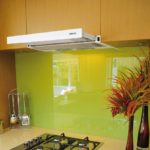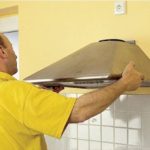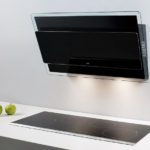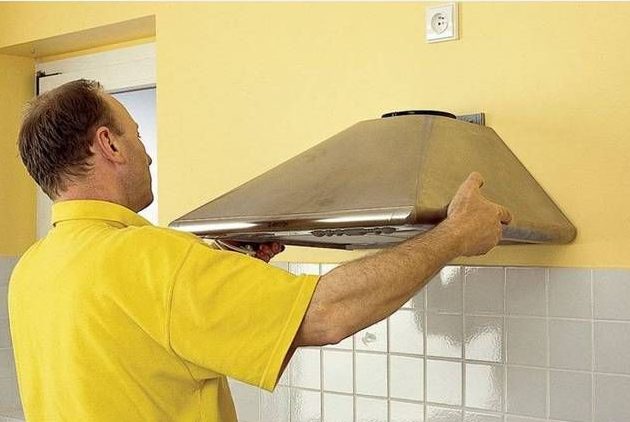Installing an inclined hood in the kitchen
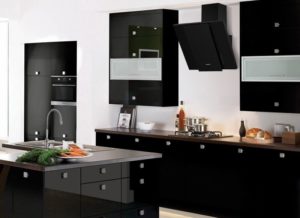 The kitchen hood has become an indispensable assistant in the kitchen. This is not surprising, because during the cooking process, a large amount of combustion products and fat particles accumulate in the air, which settle, contaminating the furniture. One of the most popular models on the market is the inclined hood, which combines a stylish, laconic design and high performance. Let's talk about the features of its installation.
The kitchen hood has become an indispensable assistant in the kitchen. This is not surprising, because during the cooking process, a large amount of combustion products and fat particles accumulate in the air, which settle, contaminating the furniture. One of the most popular models on the market is the inclined hood, which combines a stylish, laconic design and high performance. Let's talk about the features of its installation.
The content of the article
Features of installing an inclined hood in the kitchen
The method of installing an inclined hood depends on the principle of its operation. There are exhaust models - they do not purify the air, but discharge it into the ventilation shaft, recirculation models - they purify the air using carbon and grease filters, and combined models - which have maximum performance due to a combination of air exhaust and filtration.
ATTENTION! When installing diverter and combined devices, it is worth considering the presence of a ventilation hole and considering the layout of the air duct to it.
Materials and tools
If we have decided on the model, we proceed to installation. In addition to the device itself, we need:
- roulette;
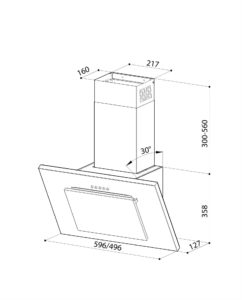
- level;
- perforator;
- screwdriver;
- pencil.
To install drainage equipment, you will additionally need a ventilation grille with a hole for the air duct, a corrugated pipe and connecting clamps.
ATTENTION! The diameter of the hole in the ventilation grille and the diameter of the corrugated pipe must be the same.
Determining the installation height of an inclined hood
The installation height of the device is individual for each model; it is indicated in the operating instructions. Despite the fact that modern appliances are equipped with heat-resistant glass, there are standard recommendations for determining the height, which depend on the type of hob.
When installed above gas stoves, the lower level must be at least 55 cm, above electric stoves - at least 35 cm.
Mounting the hood
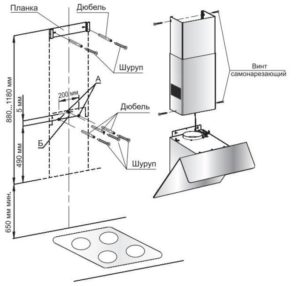 The first step is to mark the mounting holes on the wall, having first taken the dimensions from the outside of the device body. Horizontal lines on the wall are marked using a building level strictly horizontally. Check to see if there is any hidden cable running through the holes being drilled. To do this, you can use a hidden wiring detector.
The first step is to mark the mounting holes on the wall, having first taken the dimensions from the outside of the device body. Horizontal lines on the wall are marked using a building level strictly horizontally. Check to see if there is any hidden cable running through the holes being drilled. To do this, you can use a hidden wiring detector.
Afterwards, using a hammer drill, drill holes in the wall in the designated places. If the wall is tiled, then first drill into the tiles with a drill for ceramics in non-impact mode, and only then use a hammer drill to drill into the concrete. Insert dowels into the resulting holes and screw in self-tapping screws, not screwing in about 6–7 mm to the end.
Hang the device on the screws, open the glass door, remove the grease filter and screw the screws in completely. Put the filter back.
Power connection
We connect to the power supply by plugging the plug into the socket.It is advisable that the socket be installed in advance at the level of the device or hidden behind its body. The average power of a household hood is approximately 160 W. To connect it, a wire with a cross section of 1.5 mm will be enough.2.
Fastening corrugated pipe
The first step is to install a ventilation grille with a hole. We insert the corrugated pipe into the hole in the grille, secure it with clamps and coat the joints with sealant. The second end of the pipe is connected to the hood, the seams are treated with sealant. The pipe must be installed as straight as possible, avoiding steep angles.
ATTENTION! The more angles and turns there are in the duct, the less performance the hood will have. One turn reduces productivity by about 10%.
An air duct made of a corrugated pipe does not look very aesthetically pleasing and can spoil the interior of the kitchen. In order to hide it, install a decorative box made of plasterboard, which is painted to match the color of the walls or furniture, or is covered with both.
Before installing the box, you should check the operation of the hood and “run” it in all modes. If everything works properly, you can move on to the decorative box.
Advantages of the inclined hood design
In addition to the stylish and ergonomic design, the inclined hood has a number of other advantages. Such as:
- low noise level due to the use of advanced engines;

- greater productivity, which is achieved, among other things, thanks to the inclined working surface, which catches the flow of air rising from the hob during its natural movement;
- touch display, easy to clean compared to push-button display;
- automatic switching on and off and selection of optimal power for maximum performance.
The design of the inclined hood allows you to install it indoors without special skills. With proper installation of the device, microparticles of fat, burning and other unpleasant odors will be completely absorbed by the equipment, and the kitchen interior will have its own zest.

